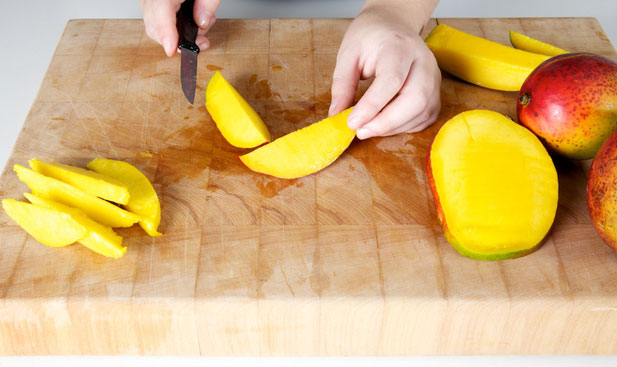

Cutting everything a day ahead and storing them separately until the day of the event is the answer. The more acidic fruits will begin to break down the less acidic if you mix the fruit the night before. You will loose a lot of the moisture in the fruit, and get a soup of liquid at the bottom.
Peel the fruit (if the peel isn't edible)Rule of thumb: if you would eat the peel of the fruit in its natural state (apples, pears, etc.), you can eat it dried. Thin-skinned dried citrus peels can also be nice if you're into their slight bitterness, so feel free to leave lemons, limes, and oranges unpeeled, too.
Slice fruit in 1/4' to 1/2' piecesThere are a few caveats here. Smaller fruits can be left whole or halved as desired. For example, strawberries can be halved or sliced into rings as shown in the photo above. Apricots can simply be halved and pitted.
Same with cherries—unless you also have a cherry pitter and want to simply pit the cherries and leave them whole. Blueberries and cranberries can be left whole, but you'll need to pierce their skin with a clean skewer or paring knife so the skins don't dry out and harden before the insides are fully dehydrated. The smaller or thinner each piece is cut, the quicker it will dehydrate, so be sure to cut each fruit variety into pieces of the same size.
Feel free to vary the size from one fruit variety to another, though—you can always remove the tray of dried apples from the dehydrator if they're done before the tray of dried mango. Spray fruit with lemon juiceThere are only we'll suggest using bottled lemon juice over fresh.
This is one of them. Its primary purpose here is to keep the fruit from browning, so it's a step you can skip entirely if you don't mind the murky visual.
The easiest way to disperse the lemon juice evenly is to keep it in a food-safe spray bottle and spritz apple slices, banana chunks, etc. Spread fruit slices in one layer on dehydrator racksWhile the fruits' edges can be touching, make sure they do not overlap, which could cause the pieces to stick together and the overlapping parts to be less dehydrated than the rest of the fruit. Keep different fruits on different trays as each type will become fully dehydrated in a different amount of time. Place fruits more likely to drip on the bottom rack so that they don't drip onto other fruits below. Follow your dehydrator manufacturer's recommendations for time and temperature.No manual?
Set the temperature between 125°F and 140°F. Dehydrating at 125°F will result in a more evenly dehydrated end product, while setting the temp to 140°F will make everything go a bit faster. Make sure to Instagram your process. Keep different types of fruit separated since drying time will vary. Photo by Chelsea Kyle, Food Styling by Anna Stockwell 8. Let the dehydrated fruit cool and become crispDepending on the type of the fruit, the size it's been cut, the humidity of the day, the power of your dehydrator, and, your fruit could be ready in as little as 6 hours or as much as 30.
Thinly sliced apples and citrus will be crisp, and become more brittle as they cool to room temperature. Grapes, cherries, strawberries, and other berries will be leathery, like raisins. Mangoes, pineapples and the like will be leathery and pliable. For longer-term storage, Condition the fruitIf you're like me and can work your way through a bowl of dried apples without breaking a sweat, this doesn't apply to you. Shadow kings hacks no survey list.
But if you've dried a ton of fruit to store it for several weeks or months, you'll want to 'condition' the fruit. This step is recommended by the and ensures all fruit is dried properly and evenly.To do it, pack the room-temperature dried fruit in a resealable plastic bag or glass jar and leave for a full week at room temperature.
Shake gently once a day—if you see any condensation inside the jar or bag, return the fruit to the dehydrator. If after 7 days you see no condensation, the fruit is ready to eat, or to store (more on that below). Store fruit for now or laterIf you're planning to eat the fruit within one month, store at room temperature in resealable jars. I like to use with screw top lids, but plastic storage containers or zip-top bags work, too.
